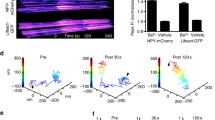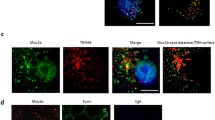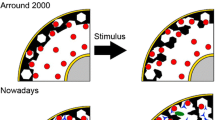Abstract
Secretory vesicles are localized in specific compartments within neurosecretory cells. These are different pools in which vesicles are in various states of releasability. The transit of vesicles between compartments is controlled and regulated by Ca2+, scinderin and the cortical F-actin network. Cortical F-actin disassembly is produced by the filament severing activity of scinderin. This Ca2+-dependent activity of scinderin together with its Ca2+-independent actin nucleating activity, control cortical F-actin dynamics during the secretory cycle. A good understanding of the interaction of actin with scinderin and of the role of this protein in secretion has been provided by the analysis of the molecular structure of scinderin together with the use of recombinant proteins corresponding to its different domains.
Similar content being viewed by others
REFERENCES
Trifaró , J-M. 1997. Common mechanisms of hormone secretion. Ann. Rev. Pharmacol. Toxicol. 17:27-47.
Trifaró , J-M., and Poisner, A. M. 1982. Common properties in the mechanisms of synthesis, processing and storage of secretory products. Pages 387-407, in Poisner, A. M., and Trifaró , J-M. (eds.) The Secretory Process. The Secretory Granule. Elsevier/North Holland.
Heinemann, C., von Rüden, L., Chow, R. H., and Neher, E. 1983. A two-step model of secretion control in neuroendocrine cells. Pflugers Arch-Eur. J. Physiol. 424:105-112.
Neher, E., and Zucker, R. S. 1993. Multiple calcium-dependent processes related to secretion in bovine chromaffin cells. Neuron 10:21-30.
Vitale, M. L., Seward, E. P., and Trifaró , J-M. 1995. Chromaffin cell cortical actin network dynamics control the size of the release-ready vesicle pool and the initial rate of exocytosis. Neuron, 14:353-363.
Vitale, M. L., Rodríguez Del Castillo, A., Tchakarov, L., and Trifaró , J-M. 1991. Cortical filamentous actin disassembly and scinderin redistribution during chromaffin cell stimulation precede exocytosis, a phenomenon not exhibited by gelsolin. J. Cell Biol. 113:1057-1067.
Burgoyne, R. D., Geisow, M. J., and Barron, J. 1982. Dissection of stages in exocytosis in the adrenal chromaffin cells with use of trifluoperazine. Proc. R. Soc. Lond.(B)216:111-115.
Parsons, T. D., Coorssen, J. R., Horstmann, H., and Almers, W. 1995. Docked granules, the exocytotic burst, and the need for ATP hydrolysis in endocrine cells. Neuron 15:1085-1096.
Bittner, M. A., and Holz, R. W. 1992. Kinetic analysis of secretion from permeabilized adrenal chromaffin cells reveals distinct components. J. Biol. Chem. 267:16219-16225.
Sudhof, T. C., and Jahn, R. 1991. Proteins of synaptic vesicles involved in exocytosis and membrane recycling. Neuron 6:665-677.
Bommert, K., Charlton, M. P., DeBello, W. M., Chin, G. J., Betz, H., and Augustine, G. J. 1993. Inhibition of neurotransmitter release by C 2-domain peptides implicates synaptotagmin in exocytosis. Nature 363:163-165.
Popov, S. V., and Poo, M. M. 1993. Synaptotagmin: a calcium-sensitive inhibitior of exocytosis? Cell 73:1247-1249.
Alvarez de Toledo, G., Fernández-Chacó n, R., and Fernández, J. M. 1993. Release of secretory products during transient vesicle fusion. Nature 363:554-557.
Trifaró , J-M., and Vitale, M. L. 1993. Cytoskeleton dynamics during neurotransmitter release. Trends Neurosci. 16:466-472.
Trifaró , J-M. 1982. The cultured chromaffin cell: a model for the study of biology and pharmacology of paraneurons. Trends in Pharmacol. Sci. 3:389-392.
Trifaró , J-M. 1984. The adrenal paraneuron, its biology and pharmacology. Can. J. Physiol. Pharmacol. 62:465-466.
Douglas, W. W. 1968. Stimulus-secretion coupling: The concept and clues from chromaffin and other cells. Br. J. Pharmacol. 34:451-474.
Douglas, W. W., and Rubin, R. P. 1961. The role of calcium in the secretory response of the adrenal medulla to acetylcholine. J. Physiol. 159:40-57.
Harvey, D. G., and MacIntoch, F. C. 1940. Calcium and synaptic transmission in a sympathetic ganglion. J. Physiol. 97:408-418.
Houssay, B. A., and Molinelli, E. A. 1928. Excitabilité des fibres adrénalino-sécrétories du neuf grand splanchnique: fréquences, seuil et optimum des stimulus: rô le de l'ion calcium. C. R. Seances Soc. Biol. Ses Fil. 99:172-174.
Jockush, B. M., Burger, M. M., Da Prada, M., Richards, J. G., Chaponnier, C., and Gabbiani, G. 1977. α-actinin attaches to membranes of secretory vesicles. Nature 270:628-629.
Trifaró , J-M., Bader, M-F., and Doucet, J. P. 1985. Chromaffin cell cytoskeleton: its possible role in secretion. Can. J. Biochem. Cell Biol. 63:661-679.
Bader, M-F., Trifaró , J-M., Langley, O. K., Thiersé, D., and Aunis, D. 1986. Secretory cell actin-binding proteins identification of gelsolin-like protein in chromaffin cells. J. Cell Biol. 102:636-646.
Rodríguez Del Castillo, A., Lemaire, S., Tchakarov, L., Jeyapragasan, M., Doucet, J. P., Vitale, M. L., and Trifaró , J-M. 1990. Chromaffin cell scinderin: a novel calcium-dependent actin filament severing protein. EMBO J. 9:43-52.
Yin, H., and Stossel, T. P. 1979. Control of cytoplasmic actin gel-sol transformation by gelsolin, a calcium dependent regulatory protein. Nature 281:583-586.
Yin, H., Albrecht, and J. H., Fattoum, A. 1981. Identification of gelsolin, a calcium-dependent regulatory protein of actin gel-sol transformation and its intracellular distribution in a variety of cells and tissues. J. Cell Biol. 91:901-906.
Stossel, T. P., Chaponnier, C., Ezzel, R., Hartwig, J. H., Janmey, P. A., Kwiatowski, D. J., Lind, S. E., Smith, D. B., Southwick, F. S., and Yin, H. L. 1985. Non-muscle actin binding proteins. Ann. Rev. Cell Biol. 1:353-402.
Tchakarov, L., Vitale, M. L., Jeyapragasan, M., Rodríguez Del Castillo, A., and Trifaró , J-M. 1990. Expression of scinderin, an actin filament-severing protein, in different tissues. FEBS Lett. 268:209-212.
Rodríguez Del Castillo, A., Vitale, M. L., Tchakarov, L., and Trifaró , J-M. 1992. Human platelets contain scinderin, a calcium dependent actin filament-severing, protein. Thromb. Haemost. 67:248-251.
Vitale, M. L., Rodríguez Del Castillo, A., and Trifaró , J-M. 1992. Loss and Ca2+-dependent retention of scinderin in digitonin-permeabilized chromaffin cells: correlation with Ca2+-evoked catecholamine release. J. Neurochem. 59:1717-1728.
Marcu, M. G., Rodríguez Del Castillo, A., Vitale, M. L., and Trifaró , J-M. 1994. Molecular cloning and functional expression of chromaffin cell scinderin indicates that it belongs to the family of Ca2+-dependent F-actin severing proteins. Mol. Cell. Biochem. 141:153-165.
Andre, E., Lottspeich, F., Schleicher, M., and Noegel, A. 1988. Severin, gelsolin and villin share a homologous sequence in regions presumed to contain F-actin severing domains. J. Biol. Chem. 263:722-728.
Ampe, C., and Vandekerchove, J. 1987. The F-actin capping proteins of Physarum polydephalum: cap42(a) is very similar if not identical to fragmin and is structurally and functionally very homologous to gelsolin: cap42(b) is Phisarum actin. EMBO J. 6:4149-4157.
Way, M., and Weeds, A. 1988. Nucleotide sequence of pig plasma gelsolin. Comparison of protein sequence with human gelsolin and other actin-severing proteins shows strong homologies and evidence for large internal repeats. J. Mol. Biol. 203:1127-1133.
McLaughlin, P. J., Gooch, J. T., Mannherz, H-G., and Weeds, A. G. 1993. Structure of gelsolin segment 1-actin complex and the mechanism of filament severing. Nature 364:685-692.
Way, M., Pope, B. and Weeds, A. G. 1992. Evidence for functional homology in the F-actin binding domains of gelsolin and alfa actinin: implications for the requirements of severing and capping. J. Cell Biol. 119:835-842.
Trifaró , J-M., Rodríguez Del Castillo, A., and Vitale, M. L. 1992. Dynamic changes in chromaffin cell cytoskeleton as prelude to exocytosis. Mol. Neurobiol. 6:339-358.
Pope, B., Way, M., and Weeds, A. G. 1991. Two of the three actin binding domains of gelsolin bind to the same subdomain of actin. FEBS Lett. 280:70-74.
Huber, R., Schneider, M., Mayr, J., Römisch, J., and Paques, E. P. 1990. The calcium binding sites in human annexin V by crystal structure analysis at 2.0 Å resolution. FEBS Lett. 275:15-24.
Chaponnier, C., Janmey, P., and Yin, H. 1986. The actin filament severing domain of plasma gelsolin. J. Cell Biol. 103:1473-1481.
Bryan, J. 1988. Gelsolin has 3 actin binding sites. J. Cell Biol. 106:1553-1562.
Marcu, M. G., Zhang, L., Elzagallaai, A., and Trifaró , J-M. 1998. Localization by segmental deletion analysis and functional characterization of a third actin-binding site in domain 5 of scinderin. J. Biol. Chem. 273:3661-3668.
Rodríguez Del Castillo, A., Vitale, M. L., and Trifaró , J-M. 1992. Ca2+and pH determine the interaction of chromaffin cell scinderin with phosphatidylserine and phosphatidylinositol 4,5-bisphosphate and its cellular distribution during nicotinic-receptor stimulation and protein kinase C activation. J. Cell Biol. 119:797-810.
Maekawa, S., and Sakai, H. 1990. Inhibition of actin regulatory activity of the 74-kDa protein from bovine adrenal medulla (adseverin) by some phospholipids. J. Biol. Chem. 265:10940-10942.
Hartwig, J. H., Bokoch, G. M., Carpenter, C. L., Janmey, P. A., Taylor, L. A., Toker, A., and Stossel, T. P. 1995. Thrombin receptor ligation and activated Rac uncap actin filament barbed ends through phosphoinositide synthesis in permeabilized human platelets. Cell 82:643-653.
Rhee, S. G., Suh, P. G., Ryu, S. H., and Sang, Y. L. 1989. Studies of inositol phospholipid-specific phospholipase C. Science 244:546-550.
Yu, F-X, Sun, H-Q., Janmey, P. A., Yin, H. L. 1992. Identification of a polyphosphoinositide-binding sequences in an actin monomer-binding domain of gelsolin. J. Biol. Chem. 267: 14616-14621.
Janmey, P. A., Lamb, J., Allen, P. G., and Matsudaira, P. T. 1992. Phosphoinositide binding peptides derived from the sequences of gelsolin and villin. J. Biol. chem. 267:11818-11823.
Zhang, L., Marcu, M. G., Nau-Staudt, K., and Trifaró , J-M. 1996. Recombinant scinderin enhances exocytosis, an effect blocked by two scinderin-derived actin-binding peptides and PIP2. Neuron 17:287-296.
Marcu, M. G., Zhang, L., Nau-Staudt, K., and Trifaró , J-M. 1996. Recombinant scinderin, an F-actin severing protein, increases calcium-induced release of serotonin from permeabilized platelets, an effect blocked by two scinderin-derived actin-binding peptides and phosphatidylinositol 4,5-bisphosphate. Blood 87:20-24.
MacLean-Fletcher, S. D., and Pollard, T. D. 1980. Viscometric analysis of the gelation of Acanthamoeba extracts and purification of two gelation factors. J. Cell Biol. 85:414-428.
Caldwell, P. C. 1970. Pages 10-16 in Cuthbert, A. W. (ed.) Calcium and Cellular Function. Macmillan and Co. Ltd., London.
Trifaró , J-M., and García, A. G. 1995. Pages 281-292 in Cuello, A. C., and Collier, B. (eds.) Pharmacological Sciences: Perspectives for Research and Therapy in the Late 1990s. Molecular and cellular mechanisms in neurosecretion. Birkhäuser Verlag Basel Switzerland.
Author information
Authors and Affiliations
Rights and permissions
About this article
Cite this article
Trifaró, JM., Rosé, S.D. & Marcu, M.G. Scinderin, a Ca2+-Dependent Actin Filament Severing Protein that Controls Cortical Actin Network Dynamics During Secretion. Neurochem Res 25, 133–144 (2000). https://doi.org/10.1023/A:1007503919265
Issue Date:
DOI: https://doi.org/10.1023/A:1007503919265




